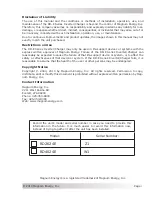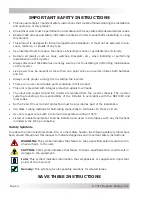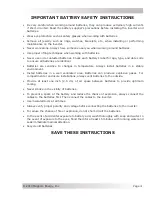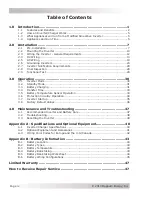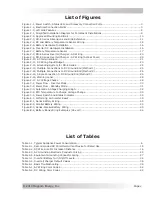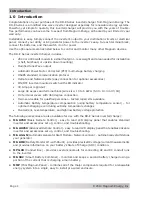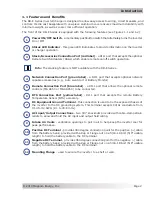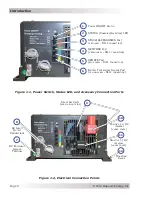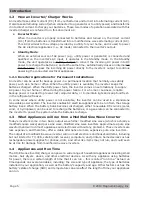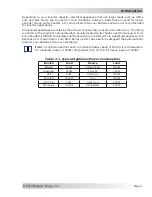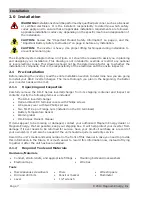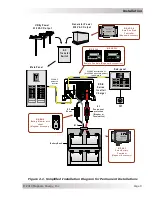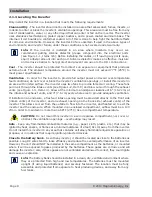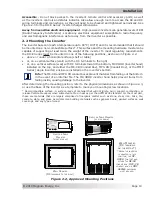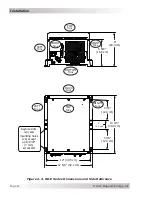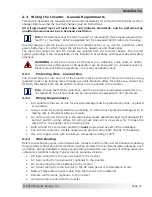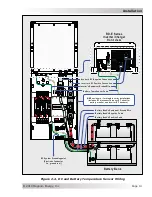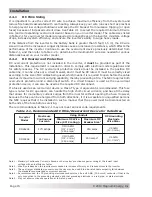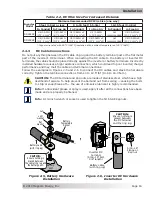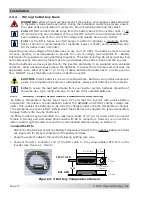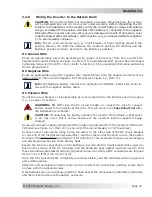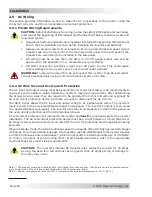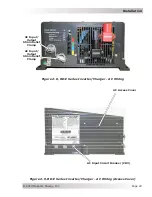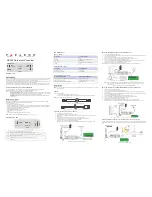
©
2010 Magnum Energy, Inc
Page 5
Introduction
1.2 How an Inverter/Charger Works
An inverter takes direct current (DC) from your batteries and turns it into alternating current (AC).
It also takes alternating current (when connected to a generator or to utility power) and transforms
it into direct current to charge your batteries. These two modes of operation associated with this
inverter/charger are referred to in this document as:
Inverter Mode
:
When the inverter is properly connected to batteries and turned on, the direct current
(DC) from the batteries is transformed into a modi
fi
ed sine wave alternating current (AC).
This AC is similar to the voltage provided by a utility for your home, and is used to power
the AC electrical appliances (i.e., AC loads) connected to the inverter’s output.
Standby Mode
:
When an external source of AC power (e.g., utility power or generator) is connected and
quali
fi
ed on the inverter’s AC input, it operates in the Standby mode. In the Standby
mode, the unit operates as a battery charger to convert the incoming AC power into DC
power to recharge the batteries; and at the same time, automatically closes an internal AC
transfer relay to pass the incoming AC power directly to the inverter’s output to continue
powering the connected electrical appliances.
1.2.1 Inverter Applications for Permanent Installations
An inverter can be used for backup power in a permanent location that normally uses utility
power, such as a home or of
fi
ce. When the utility power is available, the inverter keeps the
batteries charged. When the utility power fails, the inverter comes on automatically to supply
AC power to your home or of
fi
ce during the power failure. For a home or business, reliable
backup power is needed to prevent lost computer data, or to maintain ligts and keep food fresh
in the refrigerator/freezer.
In some areas where utility power is not available, the inverter can be used in a standalone
renewable power system. The inverter enables AC electrical appliances to be run from the storage
battery bank. When the battery bank becomes discharged, either renewable DC sources (solar,
wind, or hydropower) can be used to recharge the batteries, or a generator can be connected to
the inverter to power the system while the batteries recharge.
1.3 What Appliances will run from a Modifi ed Sine Wave Inverter
Today’s inverters come in two basic output waveforms: modi
fi
ed sine wave (which is actually a
modi
fi
ed square wave) and pure sine wave. Modi
fi
ed sine wave inverters approximate a pure sine
waveform and will run most appliances and electronics without any problems. These inverters are
less expensive, and therefore, offer a viable alternative to more expensive pure sine inverters.
The output of a modi
fi
ed sine wave inverter will run most electronic and household items, including
but not limited to: TV, VCR, satellite dish receiver, computers, and printers. Some devices such as
rechargeable power supplies for phones, drills, and other like items may not run, and could even
be at risk for damage from modi
fi
ed sine wave inverters.
1.4 Appliances and Run Time
The RD-E Series inverter/charger can power a wide range of household appliances including small
motors, hair dryers, clocks, and other electrical devices. As with any appliance using batteries
for power, there is a certain length of time that it can run – this is called “run time.” Actual run
time depends on several variables, including: the size and type of appliance, the type of batteries
installed in your application, as well as the battery’s capacity and age. Other factors such as the
battery’s state of charge (SOC) and temperature can also affect the length of time your appliances
can run.
•
•


